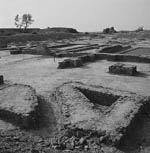A complex system of trade networks made the Harappans rich and
guaranteed access to exotic goods. Internal networks moved every
imaginable good throughout the Civilization. Shell, dried fish, and
pearls from the coast; copper, tin, chert, precious metals and
semiprecious stone from the hill country; and grain, animals, and wood
from the rural areas flowed from one area to another, resulting in a
nearly homogenous distribution of goods across the face of the
civilization irrespective of origin. Networks extended into Central
Asia, Mesopotamia, and the Arabian Peninsula. These networks exported
every good and luxury available in the Harappan Civilization. It is
unclear what was being imported, but it is likely to be wool cloth,
fish, and grain.Conventional theory suggests that an urban
center will tend to be surrounded by circular or polygonal shaped fields
(Ratnagr, 1993). Mohenjodaro and Harappa are not centered on their
respective settlement areas, but were at the apex of fan settlement
areas. S. Ratnagr has suggested that these and other large urban centers
of the Harappan Civilization acted as gateways or port cities by
funneling goods from one area to another.
Dhelvira is a fortified city
located on a small island in the Rann of Kutch (Possehl, 1999). It
existed, most likely for the regulation and protection of trade between
the central populated areas to the north and west with the smaller rural
sites in the southeast (Weber, 1999).
There are few sites in Larkana to north or west of Mohenjodaro. This
area was and is still the most fertile area of the Sind. Mohenjodaro
acted as the of trade routes over Bolan.
Harappa was probably surrounded by pastoralists. Except the small
village sites of Chak Purbane Syal and Vainiwal nearest population
concentration 150km south at Cholistan No Mature Harappan sites have
been discovered to the north and west of Harappa (Possehl, 1984). The
large number of prehistoric and historic sites suggests that sufficient
work has been completed and that the lack of Mature Harappan remains are
more likely be attributable to the nature of settlement in the Mature
Harappan.
25 Early Harappan phase sites are known from the Indus/Jhelum daub (Possehl,
1984). Daubs are the raised areas of land between rivers. These sites
were used once or for short periods by nomadic and semi-nomadic
pastoralists. From prehistoric times, the daubs have been forested
grasslands. Until the last century, they were known to be inhabited by
nomadic and cattle keeping tribes.
The possibility of existence of a continuance of Early Harappan
nomadic peoples into the Mature Harappan Period. Dani claimed Hishan
Dheri near Pahman Dheir to be of Mature Harappan date. Could they have
been around during the Mature Harappan but with Early Harappan
attributes? Gateway theory suggests that lower level centers are
tributary to a single primary center. Thus the pattern of a gateway
settlement system would resemble an elongated fan shape. A gateway
settlement can be associated with long distance trade and bulk shipment
rather than the retail trade and local exchange patterns associated with
a manufacturing base. If they are gateway settlements we can expect to
see transport and distribution facilities outweigh manufacturing in the
Mature Harappan urban centers.
Gateway theory suggests that lower level centers are tributary to a
single primary center. Thus the pattern of a gateway settlement system
would resemble an elongated fan shape. Gateway settlement can be
associated with long distance trade and bulk shipment rather than the
retail trade and local exchange patterns associated with
if H a gateway expect transport and distribution facilities outweigh
manufacturing



